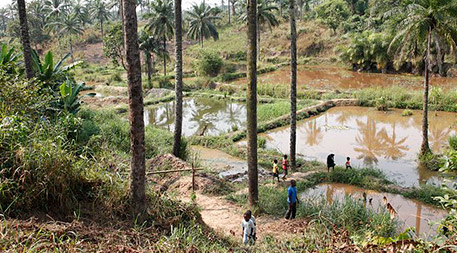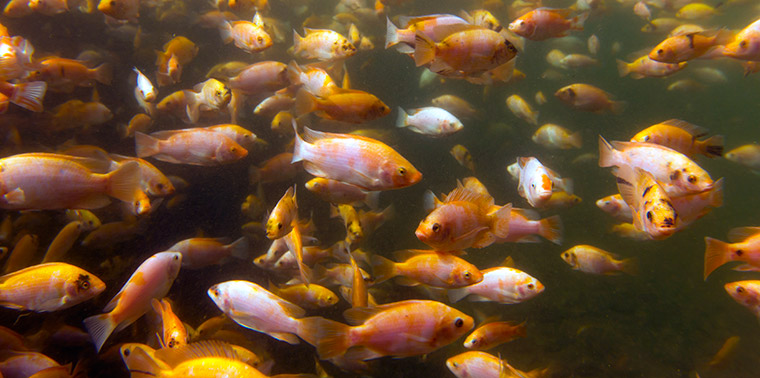January 13, 2017 — When the world is staring down a population that’s pushing quickly toward 9 billion people, aquaculture offers an efficient way to produce high-protein food for the hungry masses. But there’s a catch: While fish are feeding the multitudes of people, there may not be enough left for other fish to eat. As the farming of fish, shrimp and mollusks expands, the old adage about “plenty of fish in the sea” may no longer ring true.
The aquaculture industry is growing faster than the human population, at about 8 percent each year, according to the World Bank. And species being raised in aquaculture systems are often fed fish products, depleting wild-caught forage fish such as anchovies and krill.
“Even if the industry gets to a sustainable maximum yield, that just means we’ll take the same amount of fish out of the sea without affecting how much we want next year,” says Kevin Fitzsimmons, an aquaculture expert and environmental sciences professor at the University of Arizona in Tucson. “Nobody interviewed the whales and dolphins and seabirds as to whether they’re getting enough anchovies, menhaden and other forage fish.”

The estimated number of fish farmers grew from 3.9 million in 1990 to 16.6 million in 2010, according to the World Bank. Photo of fish-farming ponds in Masi-Manimba, Democratic Republic of the Congo, by Russell Watkins | Department for International Development
The F3 Fish-Free Feed challenge was created to accelerate the development of aquaculture diets made without fish or fish oil. Eight teams of innovators from around the world were attracted to the sustainable premise and the promise of a US$200,100 prize, raised through crowdfunding and sponsorship from the Monterey Bay Aquarium, the New England Aquarium, the University of Arizona and the World Bank. The first team to sell 100,000 metric tons (roughly 110,000 tons) of fish-free feed or, if that threshold isn’t reached, that sells the most feed by the end of the contest, on September 15, 2017, will be named the winner.
“There’s a lot of research going on out there. The problem is getting the word out in the industry and getting people to recognize that all kinds of ingredients — single-cell proteins, algal extracts or insect meals — could be used instead of fish,” says Fitzsimmons, chair of the contest committee. Beyond generating new feed formulations, he also hopes the contest will connect alternative ingredient manufacturers with feed companies and investors who can help smaller companies scale up production.
One of those smaller companies is TomAlgae, a Belgium-based manufacturer of microalgae used to feed shrimp during the earliest life stages. By growing a specific diatom under carefully controlled conditions, says company co-founder William van der Riet, TomAlgae takes the guesswork out of nutrition and avoids contamination with pathogens that can reduce the nutritional value of this food source.
The F3 challenge is a way to join with other companies producing fish-free products and create a complete chain of less fish-dependent feeds for aquaculture.“We want to replace the live algae used in hatcheries,” van der Riet says. “There is an enormous technology gap in the early stages. [Hatcheries] rely on a very artisanal way of producing their own feed when they should be relying on feed with quality that is consistent from day to day.”
This specialized feed can’t compete with the bigger companies on a tonnage level, notes van der Riet. Under ideal conditions, about 100 grams (about 3.5 ounces) of the freeze-dried micro-algae (which is rehydrated before use) could feed a million shrimp larvae and produce about 15 metric tons (about 17 tons) of shrimp meat. The F3 challenge is a way to join with other companies producing fish-free products and create a complete chain of less fish-dependent feeds for aquaculture, starting from the hatchery stage, he says.
On a larger scale, algae are being harnessed by TerraVia, a California-based company, to produce docosahexaenoic acid, or DHA, one of the omega-3 essential fatty acids found in fish oil. Roughly 400,000 metric tons (440,000 metric tons) of fish oil go into feeds for farmed salmon and trout, making aquaculture the single biggest industry for consuming long-chain omega-3s like fish oil, notes Walter Rakitsky, TerraVia’s senior vice president of emerging business.

Cutting out the “middle fish,” TerraVia’s AlgalPrime DHA can provide omega-3 essential fatty acids from algal sources, rather than using fish. Courtesy of TerraVia
TerraVia uses bioreactors in Brazil to produce DHA. Rakitsky estimates that every ton of their algae-derived DHA saves about 40 metric tons (44 tons) of wild-caught fish.
TerraVia teamed up for the F3 challenge with California-based Star Milling, an animal feed company, and TwoXSea, a fish wholesaler. Their contest entry is a rainbow trout feed produced by Star Milling and formulated for TwoXSea by U.S. Department of Agriculture research physiologist Rick Barrows to include TerraVia’s algae-made DHA as well as other ingredients such as flax oil and pistachio meal.
The quest for healthier fish food wasn’t new to TwoXSea, a company co-founded by Bill Foss, a hi-tech expat who helped start a seafood restaurant – called Fish. – to serve sustainable seafood and educate consumers.
“We treat the ocean like a toilet with everything we dump in [the water], we don’t know what inventory is in there, we can’t control it, and yet we blindly depend on it for food. That’s stupid,” says Foss. “Every consumer needs to start making educated decisions and take some responsibility — not just on farmed fish.”
The obvious solution for Foss was to stop sourcing seafood from somewhere else and start farming freshwater trout on a plant-based diet. He calls the process “renewable” rather than sustainable. “We want to be involved in things that can be replicated, so that generations from now we’ll still have access to the same fish,” he says.

Tilapia swim in floating cages in Vietnam. Photo by Khaw Hooi Ling
The Ridley Corporation, an agri-feed producer based in Australia, is focusing on developing feed additives for prawns, a seafood for which experts estimate that global aquaculture production will grow by more than 5 percent in the coming years. With a novel ingredient called Novacq, derived from microscopic marine organisms, its contest entry represents a long-term effort to develop more sustainable feeds that boost growth performance, enhance disease resistance and reduce waste.
“We’ve been looking at sustainable feed strategies for many years, so the thinking behind the competition matches ours really well,” says Sunil Kadri, head of business development at Ridley. “Whether or not we win, we want to be part of this international movement and work with like-minded people and companies. This competition gives us that opportunity.”
Those kind of opportunities are lining up. Before the next competition milestone in mid-January — a first tally of sales receipts for the new feeds — the F3 contestants are invited to a round of meet-ups with fellow competitors, selected industry insiders and investors.
“We didn’t set this up to pick winners or losers,” says Fitzsimmons of the F3 challenge. “Having all these companies talking to each other and using a fish-free diet — that’s a success unto itself.” ![]()
A version of this article originally appeared at Mongabay.
Ensia shares solutions-focused stories free of charge through our online magazine and partner media. That means audiences around the world have ready access to stories that can — and do — help them shape a better future. If you value our work, please show your support today.
Yes, I'll support Ensia!

The production of fishmeal used in animals diets has been constant at the maximum sustainable yield (MSY) for over 4 decades, while aquaculture production has increased by over 2000%. The fishmeal market has shifted from pigs and chicken food to fish/shrimp feeds, but that market shift has nothing to do with overharvesting our oceans. If you had banned fishmeal in fish diets 40 years ago, the overharvesting of the oceans would be the same.
Yes, we now know enough to make vegan diets for carnivorous fish. The question is economics of the feed alternatives not the technology.
This whole issue is sponsored by environmental activists as part of their anti-aquaculture PR campaign. All their other imaginary issues are dying as Atlantic salmon didn't take over all the rivers in the Pacific North West or people found out that mangrove land makes lousy shrimp farms or disease and pathogen flows are from nature to farms and not the other way around.
So now they are left with only their silly fishmeal arguments. We have been able to make vegan diets for fish/shrimp for a long time, but making economical diets requires using feed ingredients costs in the formulations. Removing fishmeal from chicken/pig diets and shifting that fishmeal to fish/shrimp diets has also eliminated the common problem 4 to 6 decades ago of fishy tasting chicken and turkey along with fishy tasting eggs.
With a shift to near vegan diets for fish/shrimp (fishmeal makes flavoring for some fish diets) combined with selective breeding of soy for fish feeds will allow shifting the worlds meat production from cows, pigs and chickens to seafood and take advantage of the factor of >300% increase in meat produced per kg of feed. Fish/shrimp don’t waste energy sanding up or keeping warm and are basically more food efficient. This can allow providing meat to the coming 3 billion more people on this planet without increasing agricultural land area.